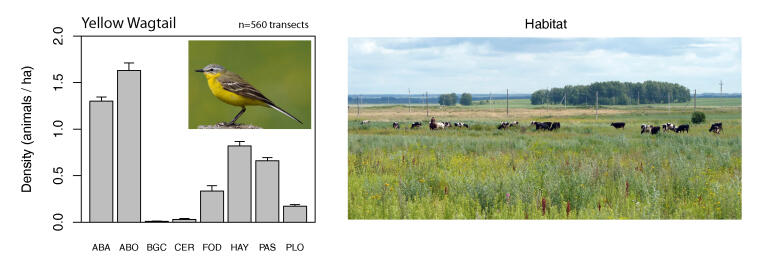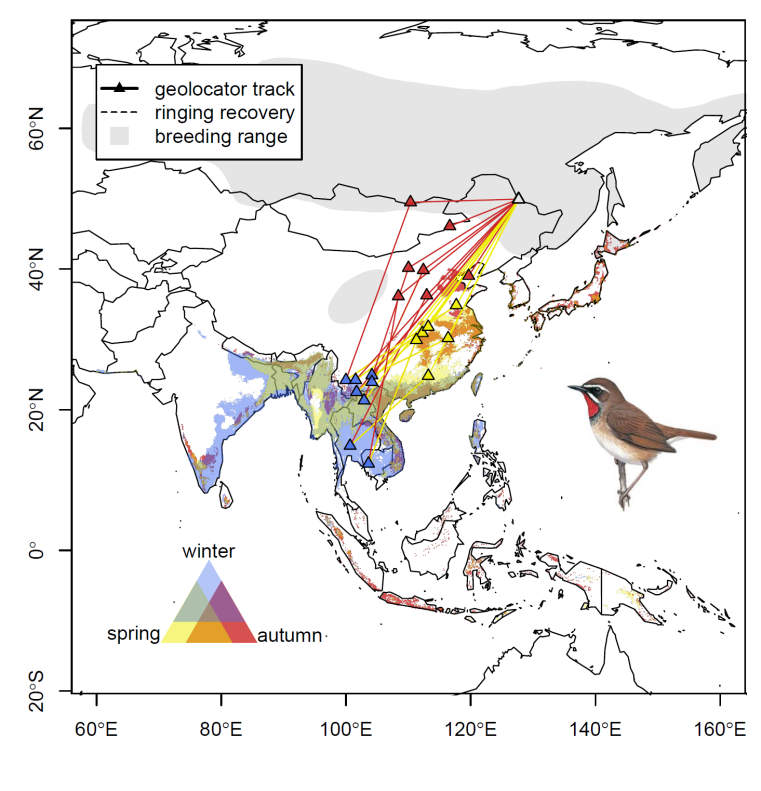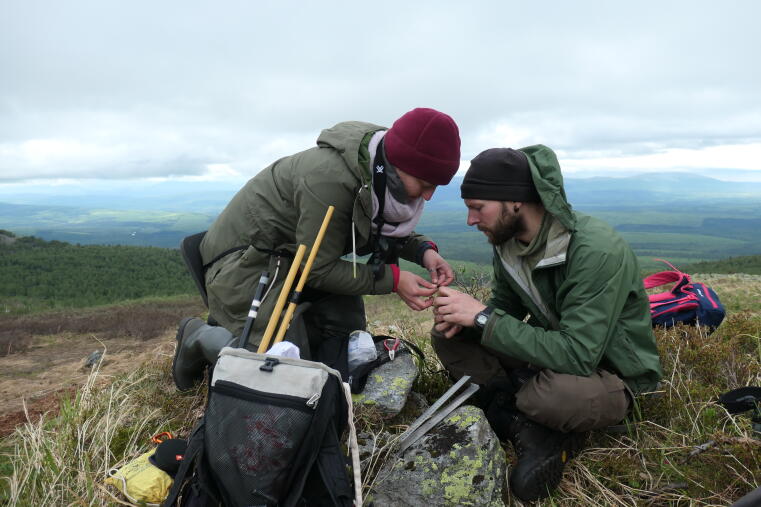
A schematic representation of the East Asian Flyway, and the fieldwork sites of the year 2019: 1) Vychegda river, Komi; 2) Mt. Kvarkush, Ural; 3) Mirnoe, Yenisei River; 4) Selenga-Delta, Lake Baikal; 5) Amur floodplain; 6) Khinganskiy zapovednik© Wieland Heim Background
Birds, especially migratory species, are excellent indicators of the state of our planet, as they are mobile and susceptible to change. The Asian migration system supports the greatest diversity and abundance of migratory birds, and hosts the largest number of globally threatened species. Compared to the European and American flyways, little is known about population trends, migration routes, migratory connectivity and threats. This is unfortunate as the systems experiences the strongest human pressure of any global flyway (Yong et al. 2015) suggest. On the breeding grounds in Siberia, the collapse of the Soviet state farming systems in 1991 led to major land-use changes. Across China, habitat at stopover sites is lost due to urban sprawl and agricultural expansion and intensification. The wintering grounds of many species, situated in Southeast Asia, have seen the highest deforestation rate of any major tropical region. Human population growth is faster in Asia than on all other continents. Concerns have been raised that massive illegal songbird persecution in East Asia has reached levels that are unsustainable and resulted in population declines. In collaboration with partners in Russia and China, we aim to contribute to a better understanding of land bird migration ecology in Asia, in order to inform future conservation strategies.
The objectives of the project are
- To explore so far untapped data resources such as monitoring data from Russian nature reserves to estimate long-term population trends, thereby identifying declining species that might then be prioritized for conservation action.
- To identify the migration routes of key species and thereby contribute basic knowledge on their year-round distribution, using satellite tracking, geolocators and stable isotopes.
- To establish the scale of persecution (illegal hunting) for key species and areas.
- To quantify land cover and land-use change using remote sensing.
- Based on the results, to identify major threats to migratory birds, and to suggest strategies to extend and improve the current protected area system in Asia to preserve the diversity of migratory birds.
Approaches
We collate and analyze existing material on population sizes and habitat preferences of migratory land birds from the breeding grounds (mainly Russia). We exploit existing databases, e.g. from the SASCHA project in Western Siberia, but also seek new collaborations with ornithologists. We focus on direct land-use change effects (e.g., cropland abandonment, Kamp et al. 2018) and indirect impacts on birds (e.g., increasing wildfire frequency due to biomass accumulation after abandonment).

Population densities of Yellow Wagtail in different habitats in Western Siberia. Soviet crop fields and hay meadows, now abandoned and overgrown with dense vegetation (categories ABA and ABO), host the highest densities – a species clearly profiting from land-use change on the breeding grounds.© Wieland Heim We have started to compile data on population trends from so far unexploited data sources, such as monitoring data from nature reserves on the breeding grounds and ringing datasets from stopovers sites.
We use colour-ringing and light-level geolocators to track the migration routes and identify key stopover and wintering sites of a number of species (in collaboration with Copenhagen University and the Swiss Ornithological Institute). We focus on the globally threatened Yellow-breasted Bunting (Emberiza aureola) and Siberian Rubythroat (Calliope calliope, Heim et al. 2018). We have successfully retrieved tracks from geolocators mounted on further species, such as Pallas’s Grasshopper Warbler (Locustella certhiola), Red-rumped Swallow (Cecropis daurica), Blue-and-white Flycatcher (Cyanoptila cyanomelana), Siberian Thrush (Zoothera sibirica) and Elegant Bunting (Emberiza elegans). By tracking different populations of the same species from across the range, we hope to find out more about migratory connectivity, and how that affects the resilience of species to various threats.

Stop-over sites and migration routes of the Siberian Rubythroat from ring recoveries and geolocator tracking; plotted on top of the modelled year-round distribution based on citizen-science data (Heim et al. submitted). Bird illustration reproduced with permission of Lynx Edicions.© Wieland Heim Furthermore, we have used citizen science data to identify key stopover and wintering regions of declining species along the flyways. We have also mapped changes in vegetation greenness across East Asia with remote sensing to develop hypotheses about change in stopover site quality.
Partners
Coordination
Johannes Kamp and Wieland Heim
Collaborators
- Amur Bird Project
- John Allcock and Caroline Dingle, Hongkong University
- Yury Anisimov, Baikal Nature Reserve
- Aleksey Antonov, Khingansky State Nature Reserve
- Stepan Boldyrev and Sergey Gashev, Tyumen State University
- Oleg Bourski, Severtsov Institute of Ecology and Evolution, Moscow
- Simba Chan, BirdLife Asia
- Lars Edenius and Adriaan de Jong, Swedish University of Agricultural Sciences
- Steffen Hahn, Swiss Ornithological Institute
- Pavel Ktitorov, BirdsRussia Sakhalin branch
- Gleb Nakul, Institute of Biology, Komi Scientific Centre, Russian Academy of Science Ural branch
- Sergei M. Smirenski, Muraviovka Park
- Kasper Thorup and Anders P. Tøttrup, Copenhagen University
Funding

© BOU, DO-G, DAAD Parts of our work have been funded by the BOU and DO-G. A number of undergraduates and MSc students received PROMOS travel grants from the German Academic Exchange Service.
Info
Updates on the 2019 fieldwork all across Russia can be found on the Amur Bird Project Blog.

Tagging a bird with a geolocator in the Ural mountains, June 2019© Wieland Heim/Amur Bird Project Selected publications
- Heim W, Chan S, Hölzel N, Ktitorov P, Mischenko A, Kamp J (accepted) East Asian buntings: ongoing illegal trade and encouraging conservation responses. Conservation Science and Practice.
- Heim W*, Wobker J*, Schmaljohann H (2021) Sex, age, molt strategy and migration distance explain the phenology of songbirds at a stopover along the East Asian flyway. Behavioural Ecology and Sociobiology 75 [doi:10.1007/s00265-020-02957-3]
- Heim W, Heim RJ, Beermann I, Burkovskiy OA, Gerasimov Y, Ktitorov P, Ozaki K, Panov I, Sander MM, Sjöberg S, Smirenski SM, Thomas A, Tottrup A, Tiunov IM, Willemoes M, Hölzel N, Thorup K, Kamp J (2020) Using geolocator tracking data and ringing archives to validate citizen-science based seasonal predictions of songbird distribution in a data-poor region. Global Ecology and Conservation 24: e01215 [doi: 10.1016/j.gecco.2020.e01215]
- De Jong A, Torniainen J, Bourski OV, Heim W, Edenius L (2019) Tracing the origin of vagrant Siberian songbirds with stable isotopes: the case of Yellow-browed Warbler (Phylloscopus inornatus) in Fennoscandia. Ornis Fennica 96: 90–99
- Edenius L, Choi CY, Heim W, Jaakkonen T, de Jong A, Ozaki K, Roberge JM (2017) The next common and widespread bunting to go? Global population decline in the Rustic Bunting Emberiza rustica. Bird Conservation International 27(1): 35–44 [doi:10.1017/S0959270916000046]
- Heim W, Eccard JA, Bairlein F (2018) Migration phenology determines niche use of East Asian buntings (Emberizidae) during stopover. Current Zoology 64(6): 681–692 [doi:10.1093/cz/zoy016] Open Access
- Heim W, Pedersen L, Heim RJ, Kamp J, Smirenski SM, Thomas A, Tottrup A, Thorup K (2018) Full annual cycle tracking of a small songbird, the Siberian Rubythroat Calliope calliope, along the East Asian flyway. Journal of Ornithology 159: 893–899 [doi:10.1007/s10336-018-1562-z]
-
Kamp J, Reinhard A, Frenzel M, Kämpfer S, Trappe J, Hölzel N (2018) Farmland bird responses to land abandonment in Western Siberia. Agriculture, Ecosystems and Environment 268: 61–69 [doi:10.1016/j.agee.2018.09.009]
-
Kamp J, Oppel S, Ananin AA, Durnev YuA, Gashev SN, Hölzel N, Mishchenko AL, Pessa J, Smirenski SM, Strelnikov EG, Timonen S, Wolanska K, Chan S (2015) Global population collapse in a superabundant migratory bird and illegal trapping in China. Conservation Biology 29: 1684–1694 [doi:10.1111/cobi.12537]
-
Richter R*, Heim A*, Heim W, Kamp J, Vohland M (2020) Combining multiband remote sensing and hierarchical distance sampling to establish drivers of bird abundance. Remote Sensing 12(1): 38 [doi:10.3390/rs12010038] Open Access
-
Sander MM, Heim W, Schmaljohann H (2020) Seasonal and diurnal increases in energy stores in migratory warblers at an autumn stopover site along the Asian-Australasian flyway. Journal of Ornithology 161: 73–87 [doi:10.1007/s10336-019-01701-7]
-
Sander MM, Eccard JA, Heim W (2017) Flight range estimation of migrant Yellow-browed Warblers Phylloscopus inornatus on the East Asian Flyway. Bird Study 64(4): 569–572 [doi:10.1080/00063657.2017.1409696]
*joint first authorship
Media coverage
Features on the drastic decline of the Yellow-breasted Bunting and illegal hunting in China, incl. contributions of our projects:
- Science eLetter
- South China Morning Post
- Nature
- The Guardian
- Deutsche Welle
- SWR radio feature (in German)
- Der Falke (in German)
- Süddeutsche Zeitung (in German)
- Russian Television (in Russian)
Messengers of a changing world
The migration ecology of Asian land birds


